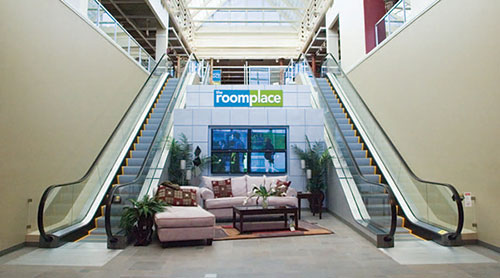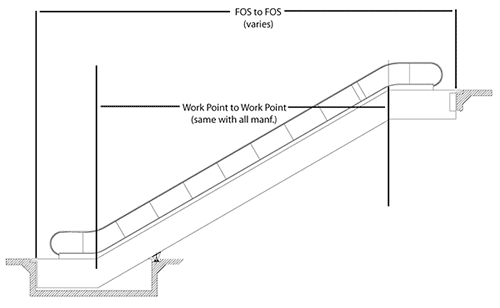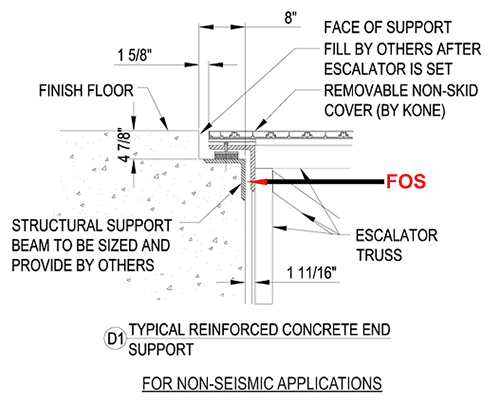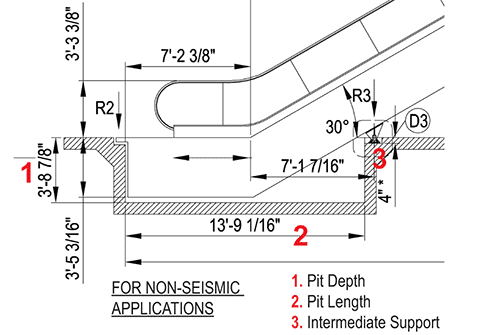Escalator Basics Today: How to Plan, Design and Update
The tracks.The track system is built into the truss to guide the steps. There are actually two tracks: one for the front wheels of the steps and one for the back wheels of the steps. The relative positions of these tracks cause the steps to form a staircase as they move out from under the comb plate. On the inclined portion of the escalators, the step track is positioned to create a staircase configuration at the steps. Then, as the steps transition at the top and bottom of the escalator, the two tracks separate to allow the steps to "flatten out" at the floor plate.
 |
| Photo courtesy KONE Inc. |
Â
Escalator steps. Most manufacturers offer steps in three widths: 24-in, 32-in and 40-in wide. The depth of any step tread in the direction of travel shall not be less than 400mm (15.75in) and the rise between treads shall not be more than 220mm (8.5in). Most steps today are fabricated from cast aluminum, which is stronger and lighter than older escalator step construction.
The handrail. As its name declares, the handrail provides a convenient handhold for passengers. Manufacturers offer a range of colors to provide an aesthetic fit.
| Escalator Modernization |
Maintained by the Port Authority of New York and New Jersey, the George Washington Bridge Bus Station has three levels?the main concourse with shops and ticket sales, the lower level with local bus and subway stops and bus platforms on the upper level. Escalators moving people between each level had been in service since the station was opened in 1963. After 40 years of heavy use, equipment malfunctions, lack of spare parts and addressing safety code changes, escalators were periodically taken out of service, thereby seriously inconveniencing the station's 20,000 daily commuters. Two alternatives were evaluated: rehabilitation and replacement, reports Port Authority engineers Dharam Pai, PE and Cheng Chang, PE. Each alternative was problematic. New replacement parts were hard to obtain and replacing the existing heavy-duty escalators required significantly more space that involved structural modifications. While exploring these options, a third was presented: a modernization package where an entirely new escalator would be installed in the existing truss. The package provided a systematic way of replacing all escalator components with new custom engineered modular ASME code and New York City building code compliant components, while avoiding significant disruptions and construction costs. Two escalators were selected as a pilot project. After extensive factory testing (the modernization was the first for the station's type of escalator) the modules were attached to the existing truss. Other components were installed in sequential fashion that followed the procedures of new escalator construction. No structural modifications were required and no major rigging, hoisting or crane requirements were necessary ? and no service interruptions. Cited as a 2007 Project of the Year by Elevator World, the two modernized escalators offer improved safety, greater reliability, lower energy use and lower operating costs. Moreover, the replacement newels, decking and stainless steel balustrades improve the appearance of the station. |
Â
ESCALATOR DESIGN CONCEPTS
Escalator geometry. Governed by ASME and CSA (Canadian Standards Association) standards in the U.S. and Canada (ASME A17.1-2007/CSA B44-07 Safety Code for Elevators and Escalators), A17.1 requires the angle of inclination for escalators not to exceed 30 degrees. (Old/historic escalators must conform to the requirements of ASME A17.3 as a minimum, where adopted by the local authority.)
This means that for a given floor to floor rise, the work point (WP) ? the point at which the 30 degree incline intersects with the floor level ? to work point (WP) dimension is always the same, regardless of the manufacturer (floor to floor rise x 1.73205.)
Since manufacturers configure escalator components differently, the distance between the floor level WP and the point at which the escalator intersects with the building structure ? known as the Face of Support (FOS) ? varies. As a result, all manufacturers' space requirements between the WP and FOS have different dimensions.
| Escalator Geometry |
 |
Source: KONE Inc. |
Â
Interfacing with the building. The distance between the FOS at the upper end and the FOS at the lower end formulates the actual structural opening of the escalator well-way. Then, an 8" pocket is typically provided at each landing to allow for the alignment of plate finishes with the walk-on plate.
| Building Interface: Face of Support Details |
 |
Source: KONE Inc. |
Â
The depth and length of the pit, number of level steps and whether or not intermediate support is required at the back of the escalator pit will all vary from manufacturer to manufacturer, depending upon the rise of the escalator and width of the steps.
| Building Interface: Pit Depth, Length and Intermediate Support Insert |
 |
Source: KONE Inc. |
Â









